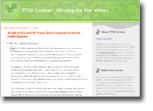 Things are not all right at home.
Things are not all right at home.
Grandmothers enlisting, fathers speaking out. Mothers arrested while a Vietnam veteran (a minister, no less) chooses death over the pain of another war.
Fathers killed, children abused and dying — too many dying. Wives murdered, wives strangled, wives drowned, wives stabbed. And strangled again. Ex-wives and their boyfriends shot. Friends slain. War buddies murdered. Cousins shooting cousins over and over, sons overeating, and banks robbed all to keep from having to return to Iraq. Others going AWOL after returning home. Desertion.
We are failing our military families. And we are failing each other. Do you have the courage to see but a sliver of the grand tragedy that is befalling our nation?
PLEASE NOTE:
The aim of this research is to shine a sliver of light on yet another burden placed on society by war. It is not to lay blame or demonize our veterans. In my eyes, they are victims, too.
I’m not interested in singling out our soldiers as if they are the only ones in society who commit crime. They’re not. Violence exists in the general population — not only amongst those suffering from combat-related PTSD. Additionally, not everyone with PTSD suffers to the same degree. Most return, folding back into society and family without harming themselves or others.
In an attempt to show respect for the veterans, I choose not to include names here or in ePluribus Media’s PTSD Timeline. This isn’t about individual acts. Rather, it’s meant to bring about a fuller understanding of what happens to the fabric of society when a nation sends another generation to war. And it’s meant to give pause and reflect on the obligation we have to make sure those we’ve sent to war are well taken care of upon their return — for their own good and ours, too.
This is the face of misunderstood, maligned, and undertreated combat-related PTSD:
Murder-suicides of husband and wife over and over and over and over again. Wives beaten, spared death, but forced to watch a husband kill himself. And himself. Girlfriends also the victims of murder-suicides. Children left behind. Mothers and fathers and brothers and sisters and spouses all affected. Forever.

Police officers killed, suicide-by-cop. Unintentional murder, and intentional. A suicide one day after a lonely Father’s day spent in a foreign land at war. War buddies murdering war buddies 72 hours after coming home from Iraq. Stateside rape and foreign, too.

Our soldiers are returning home, and don’t have to go through any mandatory counseling. The VA doesn’t have money for that. And so, stores are held up while the manager is left to die. Neighbors beaten, employers killed. More girlfriends are killed, more assaulted, former girlfriends kidnapped, robbed, and raped. Double homicide. Aggressively overreacting to a group of Sisters from the Sacred Heart of the Monastery peacefully protesting. Shooting at unarmed police officers. A 3-hour armed police standoff. Injuring strangers, some shot dead, some stabbed to death — all out of the fear and nightmares they brought home with them.

A suicide attempted by a blind, severely wounded Iraq veteran. Suicides faked and suicides accomplished. Too many accomplished. Some a mere day after getting home. Or 6. Or 30. Or 365. Suicided even while on Walter Reed Army Medical Center’s suicide watch with a bed sheet or a bathrobe sash. Poison drunk in a lonely motel room to break away from the pain. An overdose. A bridge hanging. A soldier awaiting deployment checks out when he hears the news of his brother’s KIA in Iraq. Another suicide as a 6-times decorated Army Reserve soldier who’s returned from Afghanistan finds out he’s lost his promised promotion at work.

All gone. Privates. Captains. Colonels. Brigadier Generals. Lance Corporals.

A Marine who’d personally been reenlisted by the Secretary of the Navy, Gordon R. England, at the peak of Mount Suribachi above Iwo Jima the year before. Another who only 11 days earlier was personally decorated with the Army’s Combat Action Badge by Army Chief of Staff Gen. Peter Schoomaker himself following 15 months of combat duty in which he received a purple heart and bronze star.

18 years old. 22. 23. 24. 33. 37. 40.

500 homeless already. 40,000 returned troops showing signs of mental disorder.
::
All this, and we have an administration which refuses to even utter the term ‘posttraumatic stress’ — and which also refuses to fully fund the VA. And just what type of treatment can our returning veterans expect from an administration whose key appointee to the National Advisory Council (NAC) for the US Center for Mental Health Services (CMHS) says the following:
Over the next few months, 130,000 American troops will return home from Iraq. Their arrival will bring joy to their families and gratitude from the nation. It will also renew a debate over post-traumatic stress disorder. The House Veterans’ Affairs Committee, for instance, has scheduled hearings on the disorder next week, with a focus on soldiers returning from Iraq and Afghanistan.
Likewise, just as the press has spent a year comparing the invasion of Iraq to Vietnam, it has begun drawing parallels between today’s troops and Vietnam veterans, who are believed to suffer from a high rate of war-related psychiatric disorders.
But as we try to help the soldiers of Operation Iraqi Freedom meld back into society, it would be a mistake to rely too heavily on the conventional wisdom about Vietnam. What is generally put forth as an established truth–that roughly one-third of returnees from Vietnam suffered psychological problems–is at best highly debatable. …
[T]here is an economic incentive to claim suffering. A veteran deemed to be fully disabled by post-traumatic stress disorder can collect $2,000 to $3,000 a month, tax free. More important, perhaps, the syndrome provides a medicalized explanation for many unhappy, but not necessarily traumatized, veterans trying to make sense of their experience.
Psychological studies have shown that people tend to reconstruct the past in terms of the present–they often exaggerate the degree of earlier misfortune if they are feeling bad, or minimize old troubles if they are feeling good. Thus it is vital that researchers corroborate the battlefield events that veterans cite as causes of their post-traumatic stress. Unfortunately, researchers on the 1990 readjustment study did not do the archival legwork to verify the trauma that the veterans reported. Until a better study is done, the “facts” on post-Vietnam stress are simply speculation.
Some soldiers will return from Iraq and Afghanistan with severe psychological problems, and we must do everything in our power to help them. The vast majority, however, will be able to adjust on their own–and imposing on them the questionable legacy of Vietnam won’t do them any service. As the British psychiatrist Simon Wessely has put it: “Generals are justly criticized for fighting the last war, not the present one. Psychiatrists should be aware of the same mistake.”
That was written in 2004. After all that we’ve seen befall our military families since 2004, you’d think Sally Satel, MD would revise her comments. Hardly. Instead, she’s sharpened the anti-PTSD crusade in another maligning NYT Op-Ed just this month. She deserved the scathing feedback it received.
Read more about this issue in Blaming the Veteran: The Politics of PTSD.

::
An Introduction
What is the PTSD Timeline?
It’s a collection of online news reports listing incidents related to returning combat veterans coping with PTSD. These are the most tragic of all incidents, of course, as mild cases of PTSD are hardly given a mention in our media. As a matter of fact, if it weren’t for smaller media organizations and local outlets, we’d probably never even hear about these violent cases, either.
- Can you remember the last time you heard of a soldier who’d recently returned from combat committing suicide? In the traditional press?
- Can you remember the last time you heard of a marine committing armed robbery just so he didn’t have to return to Iraq?
- Can you remember the last time you found out that a recently returned soldier killed himself and his wife in a fit of uncontrollable rage?
- Can you remember the last time you heard about a soldier going AWOL rather than return to the combat zone?
- Can you remember the last time you ever even heard or saw a public service message on this mushrooming crisis?
If our national media fails to report on this issue, does that mean it’s not important? Or do the people in pain and in harm’s way of a soldier or marine spiralling downward still exist? Is their pain relevant? Do we as a nation have a responsibility to ensure that the VA is properly funded to help meet the needs of our military families hurting the most?
Pro war or against, a helpless child or spouse abused due to the the undiagnosed or untreated pain of a veteran returned home from battle should resonate with us all. And it should compel us to act in their defense.
The purpose of the PTSD Timeline is to:
- Aid in our understanding of the magnitude of this all-encompassing problem
- Record the incidents for future study and evaluation
- Allow reporters and researchers to find OEF and OIF PTSD incident data quickly and easily
::
The Silence is Deafening
No traditional news organizations are tracking returning veteran PTSD-related incidents. The Pentagon isn’t doing it. And neither is the cash-strapped Veterans Administration (VA).
Fortunately, most soldiers, sailors, aviators, and marines return to civilian life without any major hardships — at least the type that can be seen from the outside. They fold back into their home lives, into their communities. And the fickle public happily moves on and forgets about them. They’re no longer warriors met with parades; they are simply citizens.
Then again, that’s what they really were all along, anyway. Merely citizens of our country. Our brothers and sisters. Husbands and wives. Mothers, fathers, children, or cousins. How well they cope with PTSD affects not only their own future, but that of the loved ones who surround them. Their ability to function fully and well after their return home from combat also has an immediate and real bearing on the fabric of their local community. Their health also affects our larger society as a whole.
We leave them alone to deal with their wounds (either visible or invisible) at our own national peril.
::
 Many of you are familiar with my coverage of returning veteran PTSD. Inspired to increase exposure on this topic I’ve created a new blog called PTSD Combat: Winning the War Within.
Many of you are familiar with my coverage of returning veteran PTSD. Inspired to increase exposure on this topic I’ve created a new blog called PTSD Combat: Winning the War Within.
I invite you to bookmark it and share it with others who may be returning from service overseas.




